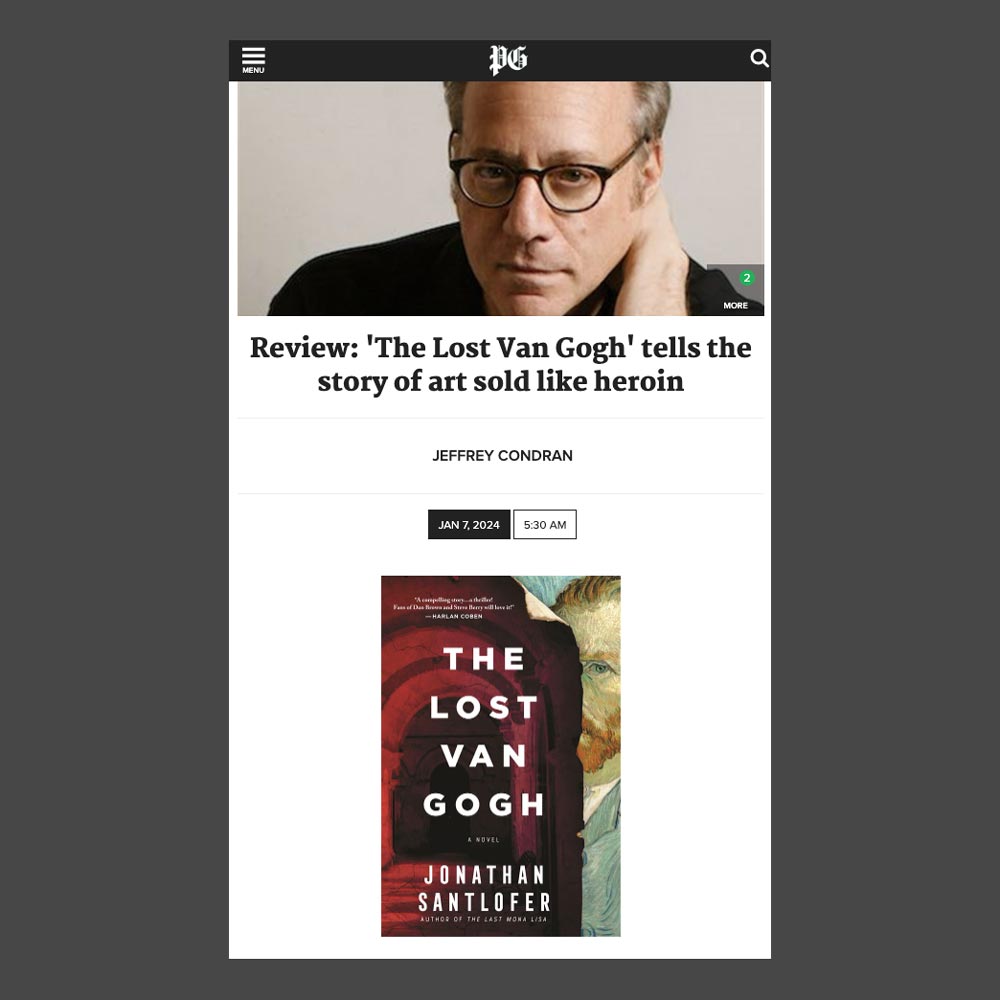By Jeffrey Condran
Jonathan Santlofer’s latest art historical thriller, “The Lost Van Gogh,” does everything the reader most admires about the genre: it’s a page-turner that follows compelling characters who not only dodge bullets — when they’re not firing them — but also engages in serious aesthetic and moral concerns regarding the value of art in people’s lives.
Vincent van Gogh is the perfect subject for this novel, as important ideas about insanity and suicide, about the notion of the solitary genius, and about the power of images, are so often attached to the Dutch painter’s life and work. The evidence, if it’s needed, is right before our eyes with the last few years bringing us immersive exhibitions and multiple films made about his life — never mind the continuing flood of merchandise printed with images of his work. Surely, people the world over know more about Van Gogh’s brushstrokes than any other artist’s.
Glimpse of a dubious world
So when a Van Gogh portrait not seen since the artist’s funeral is discovered by the painter Luke Perrone and his art historian girlfriend Alex Verde, all of the art world’s complex machinery swings into motion, including the art theft division of the international law enforcement organization INTERPOL and agent John Washington Smith.
It could be argued that few things are as subjective as the value of art, the market at the constant mercy of a relatively small coterie of tastemakers and professionals, making the process of authenticating a work essential. Much can be done to identify materials of the period and experts can weigh in regarding telltale features of the way an artist was known to work.
But a key element is provenance, tracing ownership through time from the artist who created the work to the person or organization currently in possession of it. Often this is a difficult process, especially if a painting was among the thousands of pieces looted by the Nazis during World War II. Anyone who saw the 2014 film “The Monuments Men” knows that efforts were made to recover these looted artworks. However, less well-known is the number of works that continue to be “missing” or whose ownership continues to be contested.
Mr. Santlofer’s plot gives the reader a glimpse into the dubious world of collectors and art professionals who continue to deal in and profit from artwork that was either overtly taken by the Nazis or sold under duress by Jewish owners who hoped to somehow buy their safety, revealing dark web sales techniques and covert transactions that will remind readers more of narratives dealing with blood diamonds or shipments of heroine.
They try to be the best
In the midst of all this intrigue, there also is the love story between Luke and Alex and the tense relationship between Luke and Agent Smith to entertain the reader. They are complex people who work hard to be the best versions of themselves despite difficult pasts.
However, for me, the most interesting character was Anika Van Straten, a figure who works through INTERPOL but is likely a Mossad agent, and who has a personal stake in helping to recover art taken from Jewish victims of the Nazis. There is more than one moment in novel when the characters, faced with mortal danger, are reminded by Van Straten that it’s not just a painting they’re risking their lives for, that in fact “each work of art represents a life.”
If you love moments where the top layer of paint is scraped away from an unremarkable portrait to reveal the hidden gem beneath or if you can’t resist the stories where individuals continue to push for justice in a world too often at the mercy of the cruel and the greedy, Jonathan Santlofer’s “The Lost Van Gogh” is for you.
Jeffrey Condran is the author of the story collection “Claire, Wading into the Danube By Night” and is the co-founder and publisher of the independent literary press, Braddock Avenue Books.

